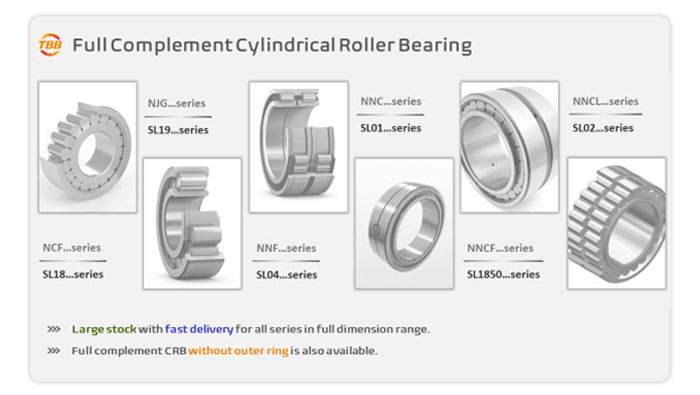
What is the most expected reason why full-complement cylindrical roller bearings are used? “The load surface is bigger than that of a ball bearing.” This observation is generally supported by an explanation like reduced vibration or the absence of the need for oil. right? In most cases, you can’t go wrong. It is essential in those aspects, but you may be unaware of the numerous other advantages of using full-complement cylindrical roller bearings (FC) over other types. In this article, we will look at what full-complement cylindrical roller bearings are, common types of full-complement CRBs, those ones popularly used in the gearbox sector, and the reasons and the key quality control points.
What is a full-complement cylindrical roller bearing?
Full complement cylindrical roller bearings are a form of rolling element bearings that contain solid internal and outer rings and integrate the greatest number of rollers as much as possible, making them suited for heavily radial loads while simultaneously saving space and having excellent stiffness. It is a type of rolling contact bearing that is commonly used in industrial equipment. Full complement cylindrical roller bearings provide a better load capacity, lower contact pressure, and longer service life than other roller bearings. They are also appropriate for high-speed rotation. It also has various advantages, such as higher stiffness, a small structure, sound isolation, and so on. As a result, these types of bearings are commonly utilized in gearboxes.

The reasons why full complement cylindrical roller bearings are used in gearboxes
The fundamental advantage of full complement bearings is the larger number of rolling components, which results in higher statically and dynamically load ratings as likened to an analogous layout with an enclosure.
Full complement cylindrical roller bearings can be used to decrease both preload and backlash in gearboxes because there is no place for either component within the whole cylinder of the bearing.
They are developed to accommodate high-pressure and heavy-duty applications. Because of their configuration, they have a higher load capacity as compared to other bearings, are less prone to contamination impairment, are more reliable and easier to maintain, and are more resistant to shock and vibration than other bearings.
Modern machinery performs at optimal performance while simultaneously minimizing attrition on machine parts when properly maintained, along with the replacement of worn or damaged parts with full complement bearings. It enables the gear teeth to completely fill the cylinder of the bearing. This deters an edge from seizing on the bearing’s sidewalls, resulting in excessive reaction and vibration.
A lower tooth density decreases drag, and noise, and optimizes bearing longevity. Preload reduction prevents chattering induced by blended gears rotating at varying paces. The outer layer also restricts the lubrication area within the bearing, lowering the average lifespan owing to oil contamination from particulates in the lubricant.

The common types of full complement cylindrical roller bearings (CRBs)
The most frequent type of bearing used in gearboxes is full complement cylindrical roller bearings. Full-complement cylindrical roller bearings minimize torque and tension in gearboxes.
To boost load capacity, full complement bearings are also constructed from an alloy. Full complement bearings are a prevalent design in modern gearboxes because of these benefits. In order to guarantee the smooth performance of the gearbox, full complement cylindrical roller bearings in the gearboxes, each bearing type has a distinct intrinsic configuration that is linked to the design of the bearing components and corresponding enclosures.

Full complement cylindrical roller bearings – Full complement cylindrical roller bearings are extensively utilized in high-speed rotational systems such as electric motors, compressors, and pumps. Full complement cage-less cylindrical roller bearings have the most rollers and can withstand far larger loads than cylindrical roller bearings of the same size; some may have extended life steel and a black oxide coating. These bearings have been developed to perform well under heavily loaded circumstances.
Single Row Full Complement Cylindrical Roller Bearings: These are suited for greater loads than caged versions of the same dimensions. Because of the greater number of rollers, the full complement single-row bearings have a higher capacity for carrying loads in exchange for a lower control rating.
Nut configurations are subjected to significant radial loads and the location must handle not only a few high radial pressures but also quite substantial lateral forces in one direction. While the bearing arrangements that operate under the conditions stated above must be extremely rigid. Quite high radial loads occur at lower velocities, implying that the exchanges are not necessary to reach speeds as high as those found in caged cylindrical roller bearings. Despite the considerable load, storage layouts are essential, and the rollers should be detachable for simpler mounting.
Double Row or Two Row Full Complement Cylindrical Roller Bearings: Are intended to withstand more radial weight than an enclosure series bearing of the same size. Because they do not have a cage, double-row full-compliment cylindrical roller bearings consist of numerous elements of rollers. Bearings with no cage have the largest number of rollers. As a result, the greater the number of rollers, the greater the radial stiffness and the longer the service life.
These types of bearings are simply dismantled and quickly fitted or removed. The augmentation in rollers leads to a boost in capacity while decreasing the speed rating. The full complement of double-row cylindrical roller bearings may be featured in floating, single-direction locating, or two-direction locating configurations and are beneficial in heavy-pressure, low-speed systems like bar straighteners and gearbox output shafts.
The bearings are greased, and a lubricating slot and opening are provided. They are also available with a corrosion inhibitor surface coating for use in harsh settings. It can also offer a resilient and adjustable solution for most lifting equipment that can withstand tilting movements.
The key quality control points in full-compliment cylindrical roller bearings
- Axial and Radial Clearance
Radial clearance is the space between the moving component’s external diameter and the raceway’s internal diameter. The bearing’s limited radial clearance causes the bearing to carry more loads. A high radial clearance, on the other hand, may generate excessive noise due to increased vibration, whereas an axial clearance is a separation between the two races along the length of the bearing. The races in an axially short bearing are closer together, resulting in less space between them. As a result, the bearing becomes stiffer and less flexible.
- Surface finish or texture
“Surface finish” refers to the surface condition of the inner race of the bearing. A smooth surface finish lowers wear by providing a low coefficient of friction between the races. A rough surface finish, on the other hand, increases the coefficient of friction and may cause early failure if not properly maintained.
- Bearing size and number of bearings
The diameter of the outer race is referred to as the bearing size. Bearings with bigger diameters may withstand more loads than smaller ones. Larger bearings require less torque to operate and so start more easily. Smaller bearings are often used for applications requiring a high starting torque. The number of rolling elements in a bearing refers to the number of balls or rollers. The load capacity of a ball bearing diminishes as the number of rolling parts increases.
- Bearing Load Capacity
Bearings with higher load capacity may withstand heavier loads before failing. High-load bearings are often suggested for applications involving heavy loads. Low-load bearings are appropriate for applications with mild loads.
- Bearing Temperature and Preload
The working temperature of the bearing is referred to as the “bearing temperature.” Overheating and premature failure are more likely at higher temperatures. Lower temperatures lessen the possibility of overheating. The thrust exerted on the bearing before rotation begins is referred to as preload. While preloading the bearing, ensure that the preload does not surpass the permitted preload. The bearing may be destroyed if the preload is too low.

Conclusion
Keeping in mind the amazing abilities of full complement cylindrical roller bearings, you must be clear about their importance in industrial gearbox. The quality of full complement cylindrical bearings also matters for the efficient working of your gearbox. This is where you need to pay attention to buying these bearings from a reliable supplier.

TBB core value: dedication excellency kindness win-win
No Comments